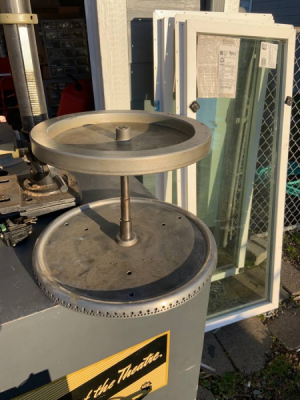- Joined
- Dec 9, 2016
- Messages
- 1,133
For the right price i would definitely buy that, for what? I have no Idea but its got plenty of value just in the plate its made from in my opinion, assuming its not painted plywood!


Go check it out in person and see if you can get a better idea what it was for?"What was the British airplane that had a stationary crankshaft? The engine was fastened to the propeller and moved around the crankshaft. "
Sopwith Camel
This is only about 20 miles from me but I'm not sure what to do with it.
 It is really hard to tell if the other parts are actually supposed to go with it or not. It's also hard to tell if the base is wood or not as the one cross brace under the base on the left side of the pic is obviously wood by the texture and splinters. Like Jim says it's a really odd mixture of heavy duty and not. Very curious.
It is really hard to tell if the other parts are actually supposed to go with it or not. It's also hard to tell if the base is wood or not as the one cross brace under the base on the left side of the pic is obviously wood by the texture and splinters. Like Jim says it's a really odd mixture of heavy duty and not. Very curious.Many WW1 aircraft used "rotary" engines. They are like a radial engine, except the crankshaft is bolted to the firewall and the crankcase and cylinders (and everything else) rotates around it. There are quite a few of them around still, but often missing parts, and almost always missing the carburetor. The carburetor was bolted to the pilot's side of the "firewall" (not), and often was scrapped with the airframe while the engines were saved, for scrap metal if for nothing else. The carburetors mostly disappeared. ~45 years ago I enrolled in a night machining class at a local high school. It was completely project based, no book work time. One of the attendees, a Scottish bagpipe player, was casting and machining lots of intricate parts. I asked him about it, and he told me he was making a short run of carburetors off copies of the original plans for LeRhone rotary aircraft engines, and told me the entire story. He gave me a tour of his home shop and his 2 restored LeRhone engines. Also interesting is that those engines do NOT have a throttle, wide open all the time. The only engine control was a push button magneto switch on the joy stick, hold it down and the engine runs at full power, let off and the power stops completely. This was a pretty big deal , because the large amount of spinning engine weight made a large gyroscopic force that made those lightweight aircraft tricky and dangerous to fly, even without being shot at! Not only that, the engine ran on gasoline mixed with castor oil, which was the total loss lubricant. Each radial cylinder had a short exhaust pipe attached to it, and the exhaust, whether burned or not, washed over the pilot sitting behind the spinning engine. At worst the exhaust could catch on fire or explode, at best it was a powerful laxative when breathed in. So much for the gallant upper class pilots having the romantic job...What was the British airplane that had a stationary crankshaft?
